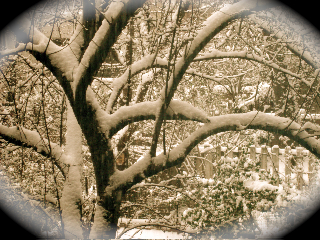I am blessed to live in the beautiful, residential West (Greenwich) Village.
A major factor making this area so special is the abundance of lush greenery -- colorful flowers, unique indigenous and exotic plantings and wonderful trees. This enhances our lives, beautifying our many public parks -- from the Hi-Line, through the Hudson River Park and our low-key Abingdon Square -- a refuge for quiet reading, neighborly chats and friendly dogs. It also cleanses the air, making us all a bit healthier and, most definitely, happier. Inspiring green foliage is also to be found flourishing in fastidiously-tended window boxes, sidewalk trees with mini plants, and marvelous, beloved "private" front and back yards.
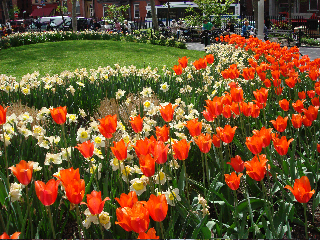
These trees also form an extraordinary habitat for a wide range of bird types, from songbirds, sparrows, blue jays, red finches, red-breasted robins, sparrows, doves, pigeons (yes, we include those urban, most beleaguered veterans), and the occasional seagull or black hawk. They serenade us all, wakening us midst the urban din to a sweet sonorous opera.
Some of these trees are hundreds of years old... great oaks, maples, linden (whose evening scent, in season, perfumes the air with a scent far beyond Chanel's #5) and crabapple.
And therein "lies the rub"!
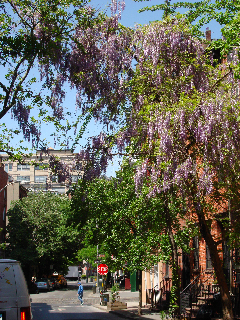
Several mornings ago, my petite pooch began barking hysterically. I rushed into the office, where my windows pictured one of those unique NYC views. In the background, the Empire State Building; mid-ground, lovely gardens; and foreground, my affluent neighbor's backyard. For three-plus decades, a large flowering crabapple tree beautified my vista and that of many others. We were heartened by the glory of its spring pink flowering and the snow-laden architecture of its branches. We watched it bear fruit and drop it for other creatures to eat, were in awe of its nesting birds, and occasionally sang along with our feathered friends. The former multi-generational owners (for decades) loved and carefully cared for that tree and also, in fact, collected my photographs documenting its wonder.
A couple of years back, new owners purchased the hundred-plus-year-old townhouse (a former home to the great poet/writer Kenneth Koch, among others.) Of course, pro forma,
they began a gut-renovation on the house. And along with the dust, dirt and noise, the workers mindlessly began throwing rubbish -- old bricks, wood, and various construction materials -- on the base of the tree. The tree moaned 'n' groaned and weakened. Yet it still served as a habitat and miraculously clung to life.
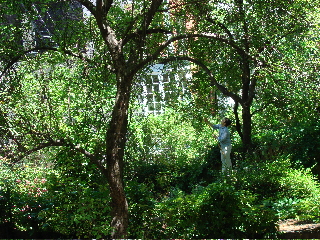
HRH, Prince Shadow was barking because small men with jig-saws were methodically cutting down the tree, in an act of unmitigated "arborcide."
Now, personally, I have lost three trees during the past few decades. All were located in private backyards, but their beautification and enhancement of their habitat were far-reaching, beyond my individual views and lifestyle.
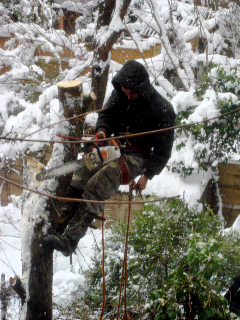
The law states that this is "legal" -- private property -- but is it ethical? My nouveau neighbor notes he will eventually replace the wonderful ole tree with a new cherry. But how long before that takes place, and how many decades -- if ever -- will it take for the cherry to reach the stately structure and important habitat of the large crabapple?
The renowned American, Joyce Kilmer's 1919 Poem Trees comes to mind...
"I think that I shall never see
A poem lovely as a tree.
A tree whose hungry mouth is prest
Against the sweet earth's flowing breast;
A tree that looks at God all day,
And lifts her leafy arms to pray;
A tree that may in summer wear
A nest of robins in her hair;
Upon whose bosom snow has lain;
Who intimately lives with rain.
Poems are made by fools like me,
But only God can make a tree".
When my first tree was taken in August 1996, I wrote, perhaps a lesser missive
A Tree Missed:
"They cut down that tree
Outside my bedroom window.
It was painful to watch!
Small men,
Scampering up branches,
With rope and saws,
And no respect.
Whatever happened to their tradition,
Of indigenous harmony with Nature?
Had it been
Westernized out of them?
Did they think it dead
Because it sported no leaves,
Like a paralyzed person
But with a rich inner life.
And what of its lush green ivy
Happily curling its way
Up the trunk,
The sonorous birds
Nestling lazily,
In its hollows,
And darting squirrels
Playing chase midst
The naked branches.
And what of me,
wakening each morn
For two decades,
The entirety of adult life,
Basking, bedside
In that spot of green,
Midst the gray-dawn of the city-scape.
Nature contained.
Nature preserved.
Nature murdered!
Some tree twigs
Landed in my bedroom,
Within their bark
They were moist and warm,
Proof of life unseen.
Did they come to say "Farewell"...
What to do
When we bear witness to
The destruction of habitat,
Environmental Depletion,
Eco-death,
Of the minimal urban green?"
It is time to herald the hopeful Million Trees NYC, the eco-initiative introduced by NYC's forward-thinking Mayor, Michael Bloomberg. This effort is an integral part of Plan NYC (now emulated by other urban mayors) to develop a green sustainable plan as the focus for city-planning.
Any ideas are welcome!
Text and Photographs (c) Jill Lynne, February 1, 2011
Photographs:
1. Beautiful, low-key Abingdon Square Park
2. Wisteria Vines & Trees Overlooking W4th St, Greenwich Village
3. Attentive neighbor carefully pruning Backyard Tree
4. Tree-Murder: "Arborcide"
5. In Memoriam: RIP: Our "Lost" Tree
www.JillLynne.com
